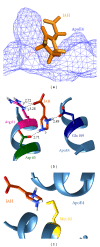Novel natural structure corrector of ApoE4 for checking Alzheimer's disease: benefits from high throughput screening and molecular dynamics simulations
- PMID: 24324968
- PMCID: PMC3845489
- DOI: 10.1155/2013/620793
Novel natural structure corrector of ApoE4 for checking Alzheimer's disease: benefits from high throughput screening and molecular dynamics simulations
Abstract
A major genetic suspect for Alzheimer's disease is the pathological conformation assumed by apolipoprotein E4 (ApoE4) through intramolecular interaction. In the present study, a large library of natural compounds was screened against ApoE4 to identify novel therapeutic molecules that can prevent ApoE4 from being converted to its pathological conformation. We report two such natural compounds PHC and IAH that bound to the active site of ApoE4 during the docking process. The binding analysis suggested that they have a strong mechanistic ability to correct the pathological structural orientation of ApoE4 by preventing repulsion between Arg 61 and Arg 112, thus inhibiting the formation of a salt bridge between Arg 61 and Glu 255. However, when the molecular dynamics simulations were carried out, structural changes in the PHC-bound complex forced PHC to move out of the cavity thus destabilizing the complex. However, IAH was structurally stable inside the binding pocket throughout the simulations trajectory. Our simulations results indicate that the initial receptor-ligand interaction observed after docking could be limited due to the receptor rigid docking algorithm and that the conformations and interactions observed after simulation runs are more energetically favored and should be better representations of derivative poses in the receptor.
Figures





References
-
- Alzheimer’s Association: Alzheimer’s disease facts and figures. Alzheimer’s & Dementia. 2012;8:1–67. - PubMed
-
- Price DL, Borchlet DR, Martin LJ, Crain BJ, Sisodiya SS, Troncoso JC. Neuropathology of Alzheimer’s disease and animal models. In: Markesbery WR, editor. Neuropathology of Dementing Disorders. 1998. pp. 121–141.
-
- Conway EL. A review of the randomized controlled trials of tacrine in the treatment of Alzheimer’s disease: methodologic considerations. Clinical Neuropharmacology. 1998;21(1):8–17. - PubMed
Publication types
MeSH terms
Substances
LinkOut - more resources
Full Text Sources
Other Literature Sources
Medical

